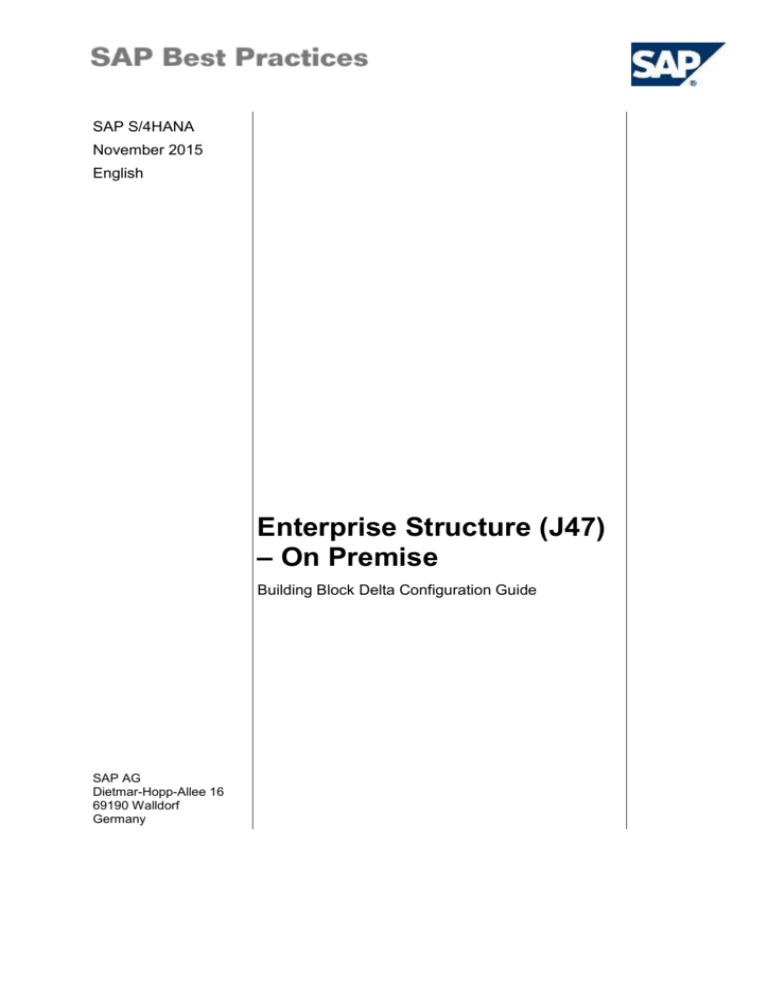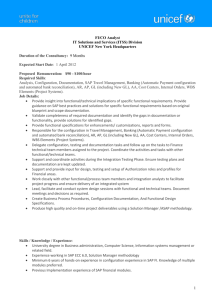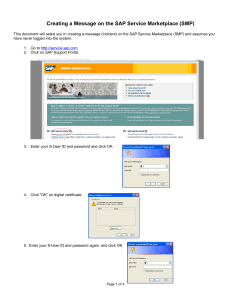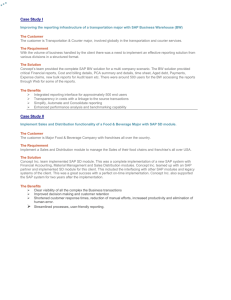
SAP S/4HANA
November 2015
English
Enterprise Structure (J47)
– On Premise
Building Block Delta Configuration Guide
SAP AG
Dietmar-Hopp-Allee 16
69190 Walldorf
Germany
SAP Best Practices
Enterprise Structure (J47) – On Premise:
Configuration Guide
Copyright
© 2015 SAP SE or an SAP affiliate company. All rights reserved.
No part of this publication may be reproduced or transmitted in any form or for any purpose without the
express permission of SAP SE or an SAP affiliate company.
SAP and other SAP products and services mentioned herein as well as their respective logos are
trademarks or registered trademarks of SAP SE (or an SAP affiliate company) in Germany and other
countries. Please see http://global.sap.com/corporate-en/legal/copyright/index.epx#trademark for
additional trademark information and notices.
Some software products marketed by SAP SE and its distributors contain proprietary software
components of other software vendors.
National product specifications may vary.
These materials are provided by SAP SE or an SAP affiliate company for informational purposes only,
without representation or warranty of any kind, and SAP SE or its affiliated companies shall not be liable
for errors or omissions with respect to the materials. The only warranties for SAP SE or SAP affiliate
company products and services are those that are set forth in the express warranty statements
accompanying such products and services, if any. Nothing herein should be construed as constituting
an additional warranty.
In particular, SAP SE or its affiliated companies have no obligation to pursue any course of business
outlined in this document or any related presentation, or to develop or release any functionality
mentioned therein. This document, or any related presentation, and SAP SE’s or its affiliated
companies’ strategy and possible future developments, products, and/or platform directions and
functionality are all subject to change and may be changed by SAP SE or its affiliated companies at any
time for any reason without notice. The information in this document is not a commitment, promise, or
legal obligation to deliver any material, code, or functionality. All forward-looking statements are subject
to various risks and uncertainties that could cause actual results to differ materially from expectations.
Readers are cautioned not to place undue reliance on these forward-looking statements, which speak
only as of their dates, and they should not be relied upon in making purchasing decisions.
© SAP AG
Page 2 of 11
Enterprise Structure (J47) – On Premise:
Configuration Guide
SAP Best Practices
Icons
Icon
Meaning
Caution
Example
Note
Recommendation
Syntax
Typographic Conventions
Type Style
Description
Example text
Words or characters that appear on the screen. These include field
names, screen titles, pushbuttons as well as menu names, paths and
options.
Cross-references to other documentation.
Example text
Emphasized words or phrases in body text, titles of graphics and tables.
EXAMPLE TEXT
Names of elements in the system. These include report names,
program names, transaction codes, table names, and individual key
words of a programming language, when surrounded by body text, for
example, SELECT and INCLUDE.
Example text
Screen output. This includes file and directory names and their paths,
messages, source code, names of variables and parameters as well as
names of installation, upgrade and database tools.
EXAMPLE TEXT
Keys on the keyboard, for example, function keys (such as F2) or the
ENTER key.
Example text
Exact user entry. These are words or characters that you enter in the
system exactly as they appear in the documentation.
<Example text>
Variable user entry. Pointed brackets indicate that you replace these
words and characters with appropriate entries.
© SAP AG
Page 3 of 11
SAP Best Practices
Enterprise Structure (J47) – On Premise:
Configuration Guide
Content
1
Purpose .............................................................................................................................. 5
2
Preparation ......................................................................................................................... 5
3
2.1
Prerequisites ............................................................................................................ 5
2.2
Deployment Options ................................................................................................. 5
2.3
Configuration ............................................................................................................ 5
Configuration – On Premise ............................................................................................... 6
3.1
4
Creation of Organization Structure .......................................................................... 6
3.1.1
Define Shipping Point and Maintain Shipping Point Address Data ..................... 6
3.1.2
Assign Shipping Point to Plant ............................................................................. 7
3.1.3
Define Loading Groups ........................................................................................ 7
3.1.4
Assign Shipping Points ........................................................................................ 8
3.1.5
Maintain Storage Location ................................................................................... 9
3.1.6
Assign Picking Locations ..................................................................................... 9
Manual Rework ................................................................................................................ 10
© SAP AG
Page 4 of 11
SAP Best Practices
Enterprise Structure (J47) – On Premise:
Configuration Guide
Enterprise Structure (J47) – On Premise:
Configuration Guide
1 Purpose
The purpose of this document is to describe the general configuration steps required to
manually set up the configuration within the system landscape that has already been installed
using the corresponding installation or configuration guides for installation.
If you do not want to configure manually and prefer an automated installation process using
BC Sets and other tools, refer to the Configuration Guide – Getting Started of your SAP rapiddeployment solution that is attached to the SAP Note.
This document supplements the existing Customizing documentation in the Implementation
Guide (IMG) and provides additional information where required.
2 Preparation
2.1 Prerequisites
Before you start installing this scenario, you must install the prerequisite building blocks. For
more information, see the Building Block Prerequisites Matrix.
2.2 Deployment Options
The configuration guide provides the implementation content for the different deployment
options/SAP Products S/4HANA:
Public cloud (PC) – minimal scope & content
On-premise (OP) – full scope and content coverage
Depending on the use case/deployment option/ S/4HANA product version, you need to
implement the required scope/content starting with the Public cloud chapter and proceed with
the next required sections.
For the full scope of the on premise scope & content – PC and OP are required
For the public cloud scope & content – PC is required; OP is not required
2.3 Configuration
The following section describes the complete settings for this building block. These settings
can be divided into three main groups:
Prerequisite settings that have to be checked and which were delivered by SAP (as part
of the standard delivery)
The term Check refers to these prerequisite settings.
Settings defined by the customer (in the customer namespace and customer-specific):
The system uses automation to request individual customer settings during the
personalization process. These settings can be initial or reused from existing SAP ERP
layers and are indicated in the text by <your value>.
Additional settings that need to be made, covered either by automation or manual
configuration (in the customer namespace).
© SAP AG
Page 5 of 11
Enterprise Structure (J47) – On Premise:
Configuration Guide
SAP Best Practices
The term Create refers to these additional settings in the text.
Configuration – On Premise
3
3.1 Creation of Organization Structure
3.1.1
Define Shipping Point and Maintain Shipping Point
Address Data
Use
In this activity, you define the shipping point 171R.
Procedure
1. Access the activity using one of the following navigation options:
IMG Menu
Enterprise Structure Logistics Execution Define, copy, delete,
check shipping point
Transaction
Code
SM30 (Customizing Object V_TVST)
2. On the Choose Activity dialog box, double-click Define Shipping Point.
3. On the Change View "Shipping Points": Overview screen, choose New Entries.
4. Make the following entries:
Field
Value
Shipping Point
171R
Description (EN)
Shipping Point 171R
Location
Country
US
Departure zone
#0000000001
Times
Factory calendar
US
Determine Times
Rounding Work Days
0
Print Picking List
Output Type
EK00
Message language
EN
Number of messages
1
Send Time
3
Transmission Medium
1
5. Choose the Address button.
6. Make the following entries:
© SAP AG
Page 6 of 11
Enterprise Structure (J47) – On Premise:
Configuration Guide
SAP Best Practices
Field
User Action or Values
House Number
3475
Street
Deer Creek
Post Code
94304
City
Palo Alto
Country
US
Region
CA
Time Zone
PST
7. Save your entries.
Result
You defined the shipping point.
3.1.2
Assign Shipping Point to Plant
Use
In this activity, you assign the shipping point to the plant.
Procedure
1. Access the activity using one of the following navigation options:
IMG Menu
Enterprise Structure Assignment Logistics Execution Assign
Shipping Point to Plant
Transaction
Code
OVXC
2. On the Change View "Shipping Points Plants": Overview screen, select the entry 1710
Plant 1 and choose the Assign button.
3. On the Shipping Points -> Plants screen, in the Shipping Point dialog box, select the entry
171R and choose Enter.
4. Save your entries.
Result
You assigned the shipping point to the plant.
3.1.3
Define Loading Groups
Use
In this activity, you define the loading groups.
Procedure
1. Access the activity using one of the following navigation options:
IMG Menu
© SAP AG
Logistics Execution Shipping Basic Shipping Functions
Shipping Point and Goods Receiving Point Determination Define
Loading Groups
Page 7 of 11
Enterprise Structure (J47) – On Premise:
Configuration Guide
SAP Best Practices
Transaction
Code
SM30 (Customizing Object V_TLGR)
2. On the Change View "Routes: Loading Groups": Overview screen, choose New Entries.
3. Make the following entries:
Loading Group
Description
0002
Forklift
0003
Manual
4. Save your entries.
Result
You defined the loading groups.
3.1.4
Assign Shipping Points
Use
In this activity, you assign shipping points to shipping conditions, loading groups, and plants.
Procedure
1. Access the activity using one of the following navigation options:
IMG Menu
Logistics Execution Shipping Basic Shipping Functions
Shipping Point and Goods Receiving Point Determination Assign
Shipping Point
Transaction
Code
SM30 (Customizing Object V_TVSTZ)
2. On the Change View "Shipping Point Determination": Overview screen, choose New
Entries.
3. Make the following entries:
Shipping
Condition
Loading Group
Plant
Proposed
Shipping Point
01
0001
1710
1710
01
0002
1710
1710
01
0003
1710
1710
02
0001
1710
1710
02
0002
1710
1710
02
0003
1710
1710
03
0001
1710
1710
03
0002
1710
1710
03
0003
1710
1710
04
0001
1710
1710
04
0002
1710
1710
04
0003
1710
1710
© SAP AG
Page 8 of 11
Enterprise Structure (J47) – On Premise:
Configuration Guide
SAP Best Practices
Shipping
Condition
Loading Group
Plant
Proposed
Shipping Point
RE
0001
1710
171R
RE
0002
1710
171R
RE
0003
1710
171R
4. Save your entries.
Result
You assigned the shipping points.
3.1.5
Maintain Storage Location
Use
In this activity, you maintain storage locations.
Procedure
1. Access the activity using one of the following navigation options:
IMG Menu
Enterprise Structure Definition Materials Management
Maintain Storage Location
Transaction
Code
OX09
2. On the Determine Work Area: Entry dialog box, in the Plant field, enter 1710 and choose
Continue.
3. On the Change View “Storage Locations”: Overview screen, choose New Entries.
4. Make the following entries:
Storage Location
Description
171C
Returns
171R
Returns
5. Save your entries.
Result
You maintained the storage locations.
3.1.6
Assign Picking Locations
Use
In this activity, you assign picking locations.
Procedure
1. Access the activity using one of the following navigation options:
IMG Menu
Logistics Execution Shipping Picking Determine Picking
Location Assign Picking Locations
Transaction
SM30 (Customizing Object V_TVKOL)
© SAP AG
Page 9 of 11
Enterprise Structure (J47) – On Premise:
Configuration Guide
SAP Best Practices
Code
2. On the Change View "Picking Location Determination": Overview screen, choose New
Entries.
3. Make the following entries:
ShPt
Plnt
Storage Conditions
SLoc
1710
1710
1710
1710
10
171B
1710
1710
20
171B
171R
1710
171R
1710
10
171R
171R
1710
20
171R
171B
171R
4. Save your entries.
Result
Picking locations are assigned.
4 Manual Rework
If you need to apply the Manual Rework procedure, the following additional manual activities
are required. These activities are listed in the table below.
Configuration activity
Manual
transport
possible
Manual action in target
system / client required
3.1.1 Maintain Address for
Shipping Points
Yes
Yes
Remarks
If a manual transport is possible, proceed as follows:
1. Log on to the source system / client.
2. Go to the customizing activity as described in the respective chapter.
3. Select all relevant table entries and put them into a transport request.
This can usually be done by choosing Table View Transport. If this is not
possible, refer to the more detailed instructions given in the respective chapter of
the affected customizing activity.
4. The new transport request must be released and imported in the target system or
client.
Also check the documentation for the related IMG activity for specific information.
If manual action in the target system or client is required, proceed as follows:
1. Log on to the target system or client.
© SAP AG
Page 10 of 11
SAP Best Practices
Enterprise Structure (J47) – On Premise:
Configuration Guide
2. Go to the respective customizing activity, and make the relevant settings as described
in the respective chapter.
© SAP AG
Page 11 of 11






